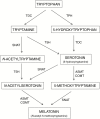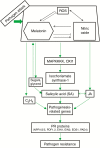Melatonin and its relationship to plant hormones
- PMID: 29069281
- PMCID: PMC5808790
- DOI: 10.1093/aob/mcx114
Melatonin and its relationship to plant hormones
Abstract
Background: Plant melatonin appears to be a multi-regulatory molecule, similar to those observed in animals, with many specific functions in plant physiology. In recent years, the number of studies on melatonin in plants has increased significantly. One of the most studied actions of melatonin in plants is its effect on biotic and abiotic stress, such as that produced by drought, extreme temperatures, salinity, chemical pollution and UV radiation, among others.
Scope: This review looks at studies in which some aspects of the relationship between melatonin and the plant hormones auxin, cytokinin, gibberellins, abscisic acid, ethylene, jasmonic acid and salicylic acid are presented. The effects that some melatonin treatments have on endogenous plant hormone levels, their related genes (biosynthesis, catabolism, receptors and transcription factors) and the physiological actions induced by melatonin, mainly in stress conditions, are discussed.
Conclusions: Melatonin is an important modulator of gene expression related to plant hormones, e.g. in auxin carrier proteins, as well as in metabolism of indole-3-acetic acid (IAA), gibberellins, cytokinins, abscisic acid and ethylene. Most of the studies performed have dealt with the auxin-like activity of melatonin which, in a similar way to IAA, is able to induce growth in shoots and roots and stimulate root generation, giving rise to new lateral and adventitious roots. Melatonin is also able to delay senescence, protecting photosynthetic systems and related sub-cellular structures and processes. Also, its role in fruit ripening and post-harvest processes as a gene regulator of ethylene-related factors is relevant. Another decisive aspect is its role in the pathogen-plant interaction. Melatonin appears to act as a key molecule in the plant immune response, together with other well-known molecules such as nitric oxide and hormones, such as jasmonic acid and salicylic acid. In this sense, the discovery of elevated levels of melatonin in endophytic organisms associated with plants has thrown light on a possible novel form of communication between beneficial endophytes and host plants via melatonin.
Keywords: ABA; JA; SA; auxin; cytokinin; ethylene; gibberellin; melatonin; phytomelatonin; plant hormone; plant pathogen; plant stress; post-harvest; rhizogenesis; senescence; tropism.
© The Author 2017. Published by Oxford University Press on behalf of the Annals of Botany Company. All rights reserved. For Permissions, please email: journals.permissions@oup.com
Figures



References
-
- Aghdam MS, Fard JR. 2017. Melatonin treatment attenuates postharvest decay and maintains nutritional quality of strawberry fruits (Fragaria×anannasa cv. Selva) by enhancing GABA shunt activity. Food Chemistry 221: 1650–1657. - PubMed
-
- Aguilera Y, Herrera T, Liébana R et al. . 2015. Impact of melatonin enrichment during germination of legumes on bioactive compounds and antioxidant activity. Journal of Agricultural and Food Chemistry 63: 7967–7974. - PubMed
-
- Arnao MB, Hernández-Ruiz J. 2007a. Melatonin promotes adventitious- and lateral root regeneration in etiolated hypocotyls of Lupinus albus L. Journal of Pineal Research 42: 147–152. - PubMed
-
- Arnao MB, Hernández-Ruiz J. 2007b. Inhibition of ACC oxidase activity by melatonin and IAA in etiolated lupin hypocotyls. In: Ramina A, Chang C, Giovannoni J, Klee H, Perata P, Woltering E, eds. Advances in plant ethylene research. Dordrecht: Springer, 101–103.
Publication types
MeSH terms
Substances
LinkOut - more resources
Full Text Sources
Other Literature Sources

